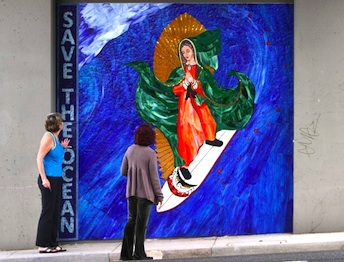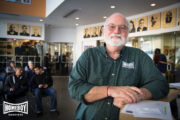In the contemporary annals of Catholic apparitions, the Virgin Mary has typically appeared in response to prayer, a conversion or a plea for healing. But until Good Friday 2011, she had never manifested as a harbinger of gnarly surf. On that day, which also happened to be Earth Day, two men disguised in construction helmets and vests erected a ten-by-ten foot glass mosaic of the Virgin Mary of Guadalupe on a train bridge along the side of a downtown road in the beach city of Encinitas, California.[1] The mural depicted the Madonna in glorious greens, blues and reds surfing a wave as she clasped her hands in prayer. Her feet were shod in surfing booties, and Juan Diego adorned the tip of the surfboard. Along the side of the piece was the message: “Save the Oceans.” The Virgin appeared to Juan Diego in 1531, but her 2011 interlocutor was later revealed to be Mark Patterson, a member of the community’s local surf culture.
Although beloved by locals, the piece worried fretful officials in Encinitas. The city eventually ordered the installation removed, but a sustained outcry convinced the civic establishment to display the artwork in a public location with proper permits. The city selected Moonlight State Beach as the site for the installation, pending approval of the state’s Department of Parks and Recreation.
In their petition to Sacramento, city officials argued, “The depiction of the cultural figure surfing fits in with the character of the City. Encinitas is known as a ‘classic California beach town’ where surfing is a major attraction. A concern for the environment and in preserving natural resources is a high priority of the community.” Thus, according to City Hall, the piece was not religious in nature; rather, it provided “a secular interpretation of the cultural figure Our Lady of Guadalupe.”[2]
The state Parks Commission disagreed. In vetoing the installation on the basis of the state constitution’s no preference clause, the state’s attorney reasoned that, given the centrality of the Virgin to the mural, “an objective observer would conclude that Parks wished to convey a message related to that potent symbol of Catholicism. And even if the message is one protecting the oceans, it is the Virgin who is stating the message.”[3] The state official refused to acknowledge that the iconic image could be deployed as a cultural or environmental figure. Regardless of context, the state concluded, the Virgin’s aura remains exclusively religious.
Technocrats might worry about the received understanding of Catholic folk art, but the image of the Virgin of Guadalupe is everywhere in Southern California—on United Farm Worker and immigrant rights protest signs, murals adorning the exterior walls of bodegas and elaborate tattoos on hipster baristas, as well as votive candles, dashboard ornaments and air fresheners for sale in supermarket aisles. Officials and local pundits hoped the reimagined surfer girl could help the city reinforce its identity as a surfing destination. To them, the piece represented the transformation of the significance of a popular icon from a narrowly sectarian niche to a broader cultural context.[4]
Denied a permanent home at the beach, in October 2013 the Surfing Madonna was relocated to a custom-built landscaped grotto on the side of the Leucadia Pizzeria, just a few feet from the site of the original installation.[5] She remains a landmark for motorists heading toward Moonlight State Beach and weekend cyclists traveling along the PCH. She is also a symbol of the environmental awareness foundation established in her honor.[6]
The city’s embrace of the Surfing Madonna exemplifies how an affluent and diverse community can appropriate popular religious symbols into its civic culture. A number of other landmarks and therapeutic practices—including the nearby Self-Realization Fellowship, the local surf spot Swami’s and the ubiquitous yoga culture that has prompted locals to dub the city “Omcinitas”—contribute to what I call the area’s progressive religious imagination, which has embraced alternative beliefs and practices as part of the California dream.[7] The Surfing Madonna may have signaled a new infusion of Latino religious symbols into California’s cultural conversation, but the decontextualized appropriation of the symbol—itself a syncretic tradition translated from Mexican into Catholic iconography—also indicated its transformation into an icon of California’s Anglo beach culture.
[1] Jonathan Horn, “Men in hardhats put up surfing Madonna mural in Encinitas,” U-T San Diego, April 25, 2011.
[2] Logan Jenkins, “Time to get serious and approve a home for the Surfing Madonna,” U-T San Diego, January 26, 2012.
[3] Jonathan Horn, “State says no to Surfing Madonna,” U-T San Diego, March 16, 2012.
[4] Logan Jenkins, “Time to get serious and approve a home for the Surfing Madonna,” U-T San Diego, January 26, 2012.
[5] Edward Sifuentes, “Surfing Madonna moves to a new location,” U-T San Diego, October 16, 2013.
[6] SurfingMadonna.org
[7] Swami’s surf report camera; New York Times story on yoga culture of Encinitas.
Eileen Luhr is a guest contributor with the USC Center for Religion and Civic Culture.



